The content of the article
Home doctor on the windowsill - fragrant geranium. In the care is absolutely unpretentious, the choice of place of residence is without whims. Adequate young lady, what can we say. But after all in search engines quite often there is a request why geranium leaves turn yellow and dry. What to do?
Some growers believe that if the description of the flower is unpretentious, it means it grows. They remembered - they take care, they did not remember - maybe they will live somehow. But after all, for any indoor plants need at least minimal care. And geranium is no exception.
Let's examine the causes of yellowing and drying of the foliage of geraniums.
Lack of light
Signs. Gradually the lower leaves turn yellow and dry, the stem is drawn out, geranium is very rare and blooms little.
Decision. Change the residence of your young lady.Put it closer to the light or even hang additional lighting fitolampa. Do not touch the leaves themselves. You can pinch the top of the head so that the geranium grows wide. Otherwise there will be only a bare stalk and a bunch of leaves at the top of the head.
If you already have such a "miracle", then the best option would be cutting cuttings and rooting. Because on a stalk new leaflets will not grow any more.
Sunburn
Decision. Geranium is, of course, light-requiring and fairly easy to tolerate direct sunlight. But there is a limit to everything. For example, in recent years, the summer of the middle band presents incredible surprises. On the windowsill the temperature is far beyond + 40 ° C. There is even a cactus wither, not like geranium.
Be sure to shade the bush for the summer with white paper or a curtain of cotton fabric. If the window design does not allow, then simply move the pot from the window sill to the table or bedside table near the window. Light will be enough, but the burn will not happen.
Excess moisture
Signs. The leaves turn yellow on the tops of the shoots, then become sluggish, watery. The last stage - the rotting of the stem and the drying of the leaves.
Decision. Stop creating a swamp in your geranium pot. Check drainage holes for clogged debris and overgrown roots. If this problem is relevant, then carefully release the holes. And it is better to completely transplant the plant into another pot.
Water your darling right. Since geranium is often placed on a sunny window, the topsoil dries out quickly enough to form a crust. But below is still quite wet. Many are lazy once again before the next watering to pick the ground and see what happens below the level of the peel. And again they water the geraniums.
Make a habit of sticking a wooden skewer or sushi stick to the very bottom of the pot for 12-14 minutes. Then take out and watch. On the unpainted wood will be clearly visible the level of moisture in the ground.
And further. Geranium has no strictly regular drinking schedule. Water is given to the plant only when the soil in the pot is almost completely dry.
Water scarcity
Signs. The leaves of geranium appear dry yellow border of a dark, almost brown shade. Pigmentation is noticeable on the whole plant.
Decision. About watering described above.It is not necessary to rush from one extreme to another and completely overdry the earthen room. Geranium is also a living plant, it likes to eat and drink. Especially in the summer and in the heat.
Do not have time to water the flower often? Attach it to more secure hands. Or change the geraniums where the temperature is lower. So the moisture from the pot will evaporate more slowly, and the roots will not suck it at the speed of the pump.
By the way, if there is an opportunity, then in the summer you can not torment the beauty with a hot window-sill, but transplant it directly into the open ground. Only not in direct sun. It is advisable where you most often run with a watering can or a watering hose. In the fall you will not recognize your geranium. Instead of a stunted sticks with yellowing dying leaves, a beautiful powerful bush with lush green shovels will grow.
Just do not plant it in the far corner of the garden or plot. After all, just forget.
Low temperature content
Signs. Border on all leaves, first red, then yellow and dry.
Decision. The normal temperature range of geranium content is in the range from +15 to + 24 ° С. The lower reading of the thermometer is not at all comfortable for the plant. The cold season is especially rich in unpleasant surprises.From the radiators of heating there is hot dry air, and from the window it blows cold and damp. So no wonder geraniums get sick.
Move the pot to a more comfortable place with an acceptable temperature and normal humidity. If this is not possible, then do the following:
- Batteries under the window cover with a thick towel or blanket. Better wet. So eliminate excessive dryness of air.
- Cold glass is fenced off from the pot with a plate of foam or a strip of foamed insulation. Even a piece of cork stand for hot, a piece of thick wool fabric will do.
- The same materials are placed under the pot to insulate the root system.
- Have a geranium on the window sill so that the shoots and leaves do not touch the glass.
As you can see, the procedures are not so complicated, and the benefits of them are enormous. Thanks to these actions, the temperature of the geranium content on the window sill is equalized in winter. It is close to the room and does not fluctuate from drafts from the window. The leaves will stop turning yellow and dry.
Fungal diseases
Signs. First, yellow spots appear on the leaflets.Over time, they grow over the entire surface. Occasionally, a gray or whitish mold can appear. Then the sheet plates dry out. The fungus infects the whole plant.
Decision. With only the beginning of the disease should immediately begin treatment. Otherwise, then geranium will not be saved. Spray with any suitable systemic fungicide. Strictly according to the instructions and without increasing the dosage.
A young plant of small size can be simply dipped completely into the treatment solution. An adult large bush, most likely, will not be able to bathe. But it is necessary to spray carefully, until all the leaf plates are wetted from the outside and inside. Because the villi retain microdroplets of the solution and do not allow it to work directly with the green mass.
If time is already missed and the plant is completely affected (the fungus has moved to the stem), then the fungicides will not help. Can you find not strongly infected shoots? Cut them with a sterile knife or blade. Then try to root. Could not find at least one healthy twig? You have to say goodbye to geraniums.
By the way, the ground from under it, too, must be thrown out.Before the next use, the pot must be decontaminated with boiling water or a hot strong solution of potassium permanganate.
Pests
Signs. Yellow small dots appear on the leaves. Unbidden guests are always clearly visible on the underside of the shovels. Sometimes there are cobwebs or sticky patches on the shoots. Then the dots grow into spots, the leaves dry. Any part of the plant can be damaged.
Decision. Found enemies? Get rid of them immediately! Not only do they suck out all the nutritive juices and vitality from geraniums, they also often carry pest bacteria and spores of pathogenic fungi.
There are recommendations to use for washing the leaves a solution of household or potassium soap. You can try. This method not bad copes with vile guests. The difficulty of its use lies in the fact that the fluff on the geranium prevents the soap solution from washing the leaves qualitatively.
In this respect, any systemic insecticide of complex action is much more convenient. Even if you do not succeed in qualitatively wetting the leaves with a solution, some of them will remain on the villi and will certainly fall on insects.
For best results, we advise you to repeat the processing again after some time.
Tightness
Signs. The leaves turn yellow evenly on the whole plant, first from the edges, then entirely. Gradually wither, remains bare trunk. There is no flowering and is not expected. From the drainage hole visible roots.
Decision. The reason is trivial: the geranium has become small its pot. This plant is quite loyal to small tanks. Transplantation requires every 3-4 years. But sometimes, with good care and high-quality feeding, the flower grows too fast. This is especially true of young plants.
Just transplant the geranium into a bigger home. Only not much. Otherwise, in the next 2 years you will not see flowers. The plant will begin to intensively build up the root system at the expense of foliage and buds. It is very important not to feed him within 3 months after transplantation. This is the time of acclimatization and addiction.
By the way, if you notice thickening, tubercles or nodes on the roots, we sympathize with you. Geranium is affected by the root nematode. This can also provoke yellowing and drying of the leaves. Unfortunately, this problem is not treated.We'll have to throw the whole plant together with the soil and the pot.
Even prolonged soaking of the container in bleach or boiling does not give 100% of the result of getting rid of the larvae and the worms themselves.
After the discovery of such filth will have to inspect all the neighboring plants. Often they also have to be disposed of. Do not buy plants in natural markets and avoid a similar fate.
Those who truly love home flowers will never be bothered by the concern why geranium leaves and leaves turn yellow and dry. What to do? - they also know very well. This article will help everyone else, including beginners.
Video: how to care for geraniums

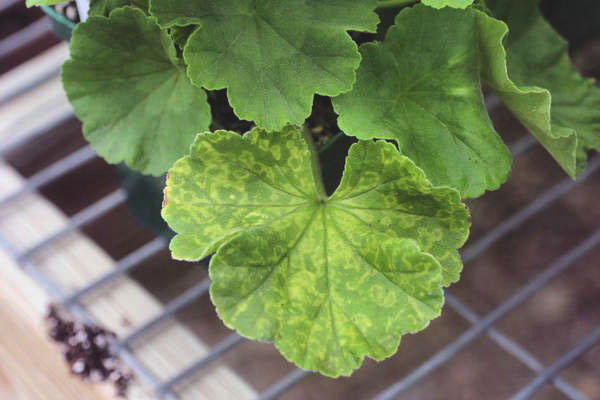
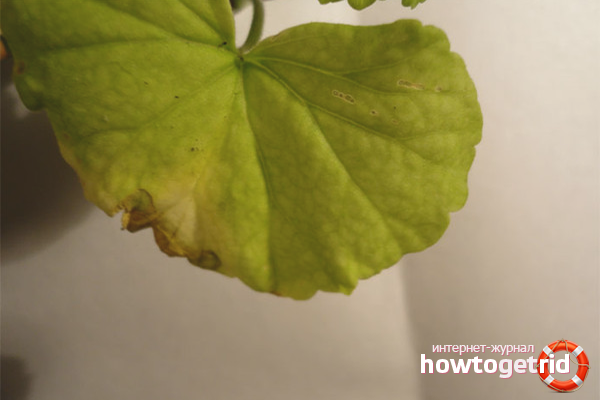
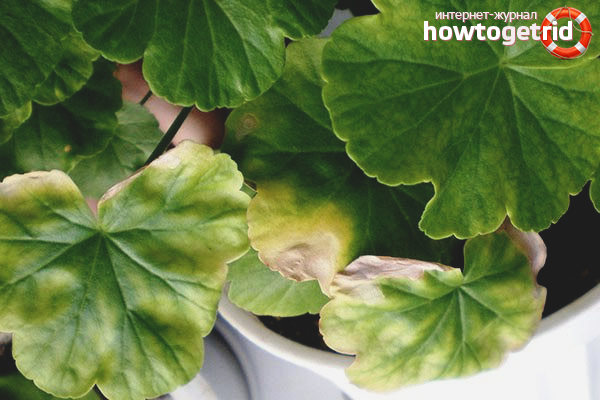


 5 votes, on average: 4,00 out of 5
5 votes, on average: 4,00 out of 5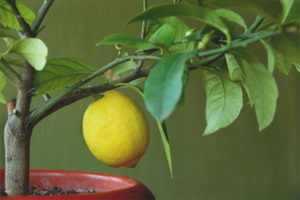
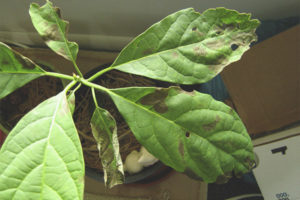


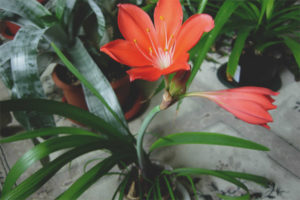

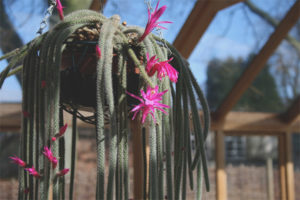
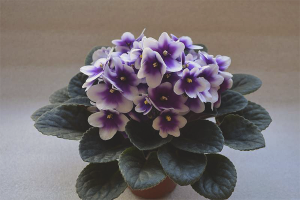
To send